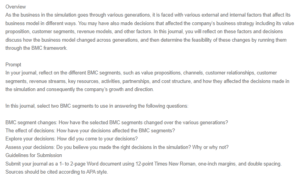Harvard Business Review Simulation and Journal
BMC Segment Changes: How the Selected BMC Segments Have Changed Over the Various Generations
Revenue Streams
Homemade’s revenue streams have changed over generations to include new products. Initially, Homemade only sold honey. By the fourth generation, the company had diversified into other gourmet foods, cosmetics, apparel, and honey. The company had also begun talks with other organizations that were already in the business of selling products such as cosmetics for acquisition or other sorts of partnerships. This meant that the entity had expanded its income sources from the different product lines.
Key Resources
The company’s key resources, specifically employees, had been family members from the beginning. However, as the second, third, and fourth generations took over the business, individuals from the external environment were included in the business. The non-family members introduced new and more reliable procedures for the organization despite increasing the cost of operations. It reduced the family’s influence on the business decisions and the conflicts that could arise from family members’ involvement in the business activities. It also increased the possibility of holding people accountable for results and establishing rules of governance and procedures (50MINUTES, 2017).
The Effect of Decisions: How the Decisions Have Affected the BMC Segments
Increasing the number of products expanded the market that Homemade catered to. Each product was created for different markets leading to a wider market share. As the market share expansion occurred, the revenue also increased. Thus, the shareholders were impressed by the performance of the business due to increased profits. Furthermore, the business costs increased because more activities and employees alongside other aspects increased.
The inclusion of external human resources promoted the business in various ways. First, the presence of employees increased the business’ professionalism, enabling competition in the market. In addition, the cost of labor increased because the diversification of products placed more demand on the need for additional human resources. The inclusion of external human resources enabled the management to establish clear rules and regulations that would guide the entity’s operations (COSO, 2017).
Exploring Decisions
The decisions made during the simulation were based on the current generation’s challenges and the most important aspects or priorities for the business. For instance, the family members’ commitment was unreliable because of conflict during decision-making. In addition, seeking to include external human resources in the business was expected to heighten standards of professionalism. Most importantly, the diversification of products and services was intended to increase profitability and enable the company to compete more efficiently in the market. This decision was also considered due to the increased market players offering honey at cheaper rates.
Assessing the Decisions
The decisions that were made were right. To begin with, the company expanded and could still operate without interference from or dependence on the family members. The external human resources, the establishment of rules and regulations, and the mixed board enabled the entity to operate independently (Adolphus, 2021). The diversification of the products enabled the organization to compete more efficiently by offering additional products to the market. It also facilitated expansion into new markets, increasing the sustainability of the business and income. The decision to list in the Initial Public Offering (IPO) provided more capital for the business to operate and expand when necessary. Based on the shareholders’ positive feedback and the increased revenue, the right decisions were made.
References
50MINUTES. (2017). The Business Model Canvas: Let your Business Thrive with this Simple Model Management & Marketing. 50Minutes.com.
Adolphus, M. (2021). Performance management and human resource development. Emerald Publishing Limited.
COSO. (2017). Enterprise Risk Management Integrating with Strategy and Performance.
ORDER A PLAGIARISM-FREE PAPER HERE
We’ll write everything from scratch
Question

Harvard Business Review Simulation and Journal
Overview
As the business in the simulation goes through various generations, it is faced with various external and internal factors that affect its business model in different ways. You may have also made decisions that affected the company’s business strategy including its value proposition, customer segments, revenue models, and other factors. In this journal, you will reflect on these factors and decisions discuss how the business model changed across generations, and then determine the feasibility of these changes by running them through the BMC framework.
Prompt
In your journal, reflect on the different BMC segments, such as value propositions, channels, customer relationships, customer segments, revenue streams, key resources, activities, partnerships, and cost structure, and how they affected the decisions made in the simulation and consequently the company’s growth and direction.
In this journal, select two BMC segments to use in answering the following questions:
BMC segment changes: How have the selected BMC segments changed over the various generations?
The effect of decisions: How have your decisions affected the BMC segments?
Explore your decisions: How did you come to your decisions?
Assess your decisions: Do you believe you made the right decisions in the simulation? Why or why not?
Guidelines for Submission
Submit your journal as a 1- to 2-page Word document using 12-point Times New Roman, one-inch margins, and double spacing. Sources should be cited according to APA style.

